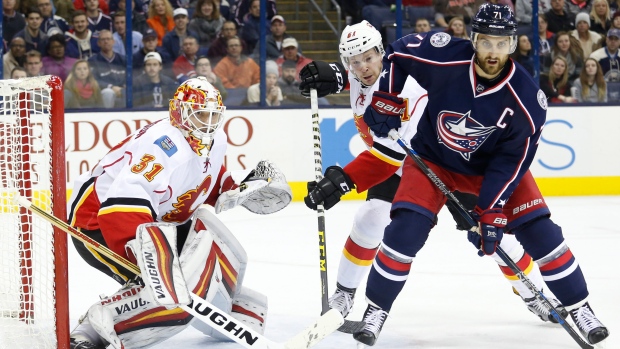Nov 29, 2016
Johnson proving he’s more than a journeyman
Calgary goaltender’s career numbers show he deserves the opportunity to start more games, Travis Yost writes
By Travis Yost

Right now, Chad Johnson is known as the goaltender who might be saving the Calgary Flames season.
But before his impressive 11-game run, Johnson was your prototypical journeyman goaltender, bouncing around from NHL city to NHL city without ever getting much of a crack at so much as a timeshare in the crease.
To some, Johnson is probably best remembered as the guy the Buffalo Sabres acquired when they were somewhere between passively and actively trying to lose games in the Connor McDavid sweepstakes. In that one-month stretch, the Sabres moved out both well-performing netminders in Jhonas Enroth (to Dallas) and Michal Neuvirth (to Long Island) for a couple of short-term goaltending options and future assets.
One of those short-term options was the aforementioned Johnson. He went on to play a very respectable 45 games for the Sabres in 2015-16, posting a .920 save percentage for one of the worst 5-on-5 teams in the league.
Johnson was never much of a long-term option for general manager Tim Murray and the Sabres. Their bet was on the recently acquired Robin Lehner, and that meant letting the productive Johnson slide into free agency. Johnson went on to sign a team-friendly one-year contract with Calgary – a contract that he may have already paid back.
The intent in Calgary this season was for Johnson to spell Brian Elliott for 20 or so games this year, but Elliott’s early struggles forced the coaching staff to tighten up the rope a bit and look for opportunities to give Johnson some time. Elliott, year-to-date, has stopped 88.2 per cent of shots. Johnson is at 92.8 per cent.
I’m still bullish on Elliott – even if Ken Hitchcock’s system has softened workload for goaltenders (and it has), Elliott’s been an above average performer for some time now. The thing is, so has Johnson, and that was overlooked by just about everyone this summer.
One of my favorite things to do when illustrating the subtleties of player performance is to do a blind test against other goaltenders around the league. It helps kill preconceived biases and lets the numbers tell the story – something I think is important here.
Johnson came into the league as a backup option in 2013-14. So, let’s look at six regular goaltenders since that season and their respective save percentages in that timespan. Any guesses which player Johnson is?
Guess Who?
| Type | Goalie A | Goalie B | Goalie C | Goalie D | Goalie E | Goalie F |
|---|---|---|---|---|---|---|
| 5-on-5 SV % | 92.5 | 92 | 92.4 | 92.4 | 92.2 | 92.8 |
| All Situations SV % | 92 | 91.7 | 91.7 | 91.2 | 91.6 | 91.9 |
This becomes a numbers exercise but it’s pretty easy to get some order here – Goalie A and F look the best, followed by Goalie C. Goalie B looks like he probably belongs too.
So, let’s add in the names of these goaltenders and one other piece of information – the amount of money their respective team is on the hook for contractually.
Bargain Goaltender
| Type | Varlamov | Lehner | Johnson | Reimer | Halak | Elliott |
|---|---|---|---|---|---|---|
| 5-on-5 SV % | 92.5 | 92 | 92.4 | 92.4 | 92.2 | 92.8 |
| All Situations SV % | 92 | 91.7 | 91.7 | 91.2 | 91.6 | 91.9 |
| AAV ($M) | 5.9 | 2.3 | 1.7 | 3.4 | 4.5 | 2.5 |
The question you have to ask yourself after seeing just the cap hits – liabilities are another story, but only make the point I’m going make stronger, I’d argue – is whether or not teams are really getting this goaltender stuff right. I think you could make the argument that Johnson is the third best performing goaltender of this group, and he’s being paid peanuts relative to some of these other guys. The best direct comparable would be Florida’s James Reimer – a goaltender he’s out-performed (albeit in less workload) and who is going to make not just $3.4 million a year, but $17 million by the time his contract expires.
Maybe Reimer is worth that much, but if Florida was right to bet on him being the future in Florida post-Luongo, how does one reconcile Johnson signing for such a team-friendly deal this summer? The easy answer is that there weren’t many landing spots for him, and when demand is low, player-side contracts tend to suffer.
But it’s not as if Johnson’s timing was just bad. Buffalo decided that the final year of Robin Lehner’s RFA-deal was probably the better immediate option, and that Anders Nilsson – who makes $700,000 less, it must be noted – would provide a better backup option.
You see Lehner’s numbers there. Career-to-date, it’s hard to argue he’s out-performed Johnson so far. At best, they are close. Nilsson has been an appalling option for just about any team in his career, so I guess the argument there is that simply because he’s cheaper, he’s better.
All this to say: Johnson is having a quality run, yes, but he’s also been a quality goaltender for 112 games and thousands of shots against. At some point, you have to start asking about whether or not this is the sort of player that should be getting more opportunity to start at the NHL level.
His performance in Calgary so far this season suggests that’s the case.

